Archaeologia Volume 2 Section XXXV
Archaeologia Volume 2 Section XXXV is in Archaeologia Volume 2.
21 Jun 1770. A Description of the Sepulchral Monument at New Grange [Map], near Drogheda, in the County of Meath, in Ireland. by Thomas Pownall, Esq; in a Letter to the Rev. Gregory Sharpe, D. D. Master of The Temple. Read at the Society of Antiquaries, June 21, 28, 1770.
Rev. Sir,
The sole object I had in view when I first sat down to write, was to give you an account of a very singular and curious monument of antiquity at New Grange, in the county of Meath, in Ireland; and I meant to have confined this account to a mere description of particulars. But when I came to consider these particulars under reference to the general customs of times more remote than the highest antiquity this monument can be supposed to boast; that consideration opened a field for disquisitions of a much more general and extensive scope.
Sepulchral tumuli, or monuments of earth raised over the dead bodies of great and famous persons, are not confined to the British Isles; but are found dispersed in different parts of Europe. We hear of them in Sweden, Denmark, Poland, Russia, and even the stepps or desarts of Tartary; but with this remarkable circumstance, as Monsieur de Stehlin, secretary of the Imperial academy at Petersbourg, informs me, that there is not an instance of one of these tumuli found in any place to the northward of the latitude 58. As these sepulchral monuments are in the language of these northeastern parts (whence perhaps the custom derived among us) called Bougors, it looks as if with the use we had derived also the name given to these monuments; for we call them here Burrows or Barrows.
Curiosity or avarice have excited many persons at different periods to examine into the interior parts of those repositories of the dead; the former in hopes of recovering from the oblivion of the grave something at least which might give an insight into the manners and customs of former times, which might become a leading mark to the reviviscence of the history of those times; the other, instigated only by the sordid hope of plunder. In ransacking the smaller Barrows in almost every country, bits of bridles, heads of spears, pole-axes, swords, glass-beads, and other trifling ornaments, have been found; as also cinerary urns. But the labour and expence attending the search into the contents of the great Barrows; such as that at Abury called Silbury [Map], that at Marlborough, and others of the like sort, has hitherto deterred individuals, or even small bodies of people, from the attempt; so that those great Barrows which, might seem to promise the highest: gratification both to avarice and curiosity, remained long secure against both. Even in Tartary, where the people formed themselves into little plundering parties, in order to derive a kind of traffic from the pillage of those sepulchral tumuli, the great ones escaped their rapine; so that for many ages the contents of these great Barrows continued sacred and secret. For several ages, in like manner, the Pyramids of Egypt (those mountains of architecture) remained as much a mystery, ino respect of their interior contents; as they were objects of wonder, from their exterior enormous bulk.
Accident, in a course of time, has, in some, and motives of curiosity, assisted by the authority of government, have, in others, led to a search and discovery of the contents of the largest of these sepulchral monuments. Some of the great Barrows in the stepps of Tartary have of late years been opened and examined by order of the Russian government; and very curious discoveries have been made, as I shall explain in the course of this letter. A cemetery, containing matters of considerable value, as well as of great curiosity, was found at the centre of the base of one of the largest of them.
In the largest of the Egyptian Pyramids accident discovered an opening, which led by two succeeding galleries to a square room in the centre of the Pyramid, containing a large tomb. What was found there (if any thing was found) was secreted, and must for ever remain as unknown, as if the centre of this monument had remained unprophaned.
Accident in like manner about the end of the last century discovered an opening in the side of the great Pyramid at New Grange in Ireland; and this aperture, by a like gallery, led in like manner to a cemetery composed of three tabernacles or niches in the centre of the base.
Accidents so similar, coinciding in so strangely similar discoveries, opened to me views of inquiry, which my curiosity could not refill. Being in Ireland last year, I determined to examine these matters on the spot with my own eyes.
By the civility of Mr. Boyd, merchant of Dublin, who went with me to Drogheda, I was introduced to the acquaintance of Dr. Norris, master of the great school there; who very politely offering to conduct me to New Grange: I profited of so agreeable an opportunity;.
Our road ran on the north and west side of the river Boyne. In our way we passed by the famous ford, where I had the pleasure to survey the very scene of the principal action of the battle of the Boyne. An elegant obelisk is erected there, in perpetual memorial of that glorious event, and a society instituted for the annual celebration of that day, as of an æra of civil liberty. Mr. Wright has prefixed to his Louthiana a neat and accurate drawing of this monument. From hence, crossing a little brook which runs into the Boyne, we passed on to the seat of Lord Neterville, in the county of Meath. The whole of the land on the north and west side of the Boyne, is high ground. The scite of Lord Neterville’s house, where the river and land make a flexure, is more eminent than the rest. On the left hand of the road, as you ascend the hill, is an ancient monument, composed of a circle of large unhewn stones, set on end; with the remains of a Kistvaen forming the north side thereof. This is undoubtedly an erection of Druid superstition. I paced the diameter of this circle, and, as well as I recollect, it is not above one and twenty feet. The stones are large and massive, and about five and six feet high. There remain1 eight of these stones together in one part of the circle; two in another part; and one by itself. On the left hand from the entrance into the circle, lies a large flat stone, which seems to have been either the top of a Kistvaen, or a Crômlech.
Note 1. This Druid circle now stands on the brink of a stone-quarry ; and the labourers were at work close Under it so that in a year or two it may be undermined, and thrown down.
About a hundred yards in the same line further from the road are the vestigia of an oval camp, which is certainly Danish As the road advances, just on the brow of the hill, and before it descends again to New Grange, there is on the left hand a very large tumulus or barrow, under which (report says) there is a cave like that at New Grange. It is now (like the mount at Marlborough [Map]) improved into a garden mount, planted with trees; and on the top of it is built a modern ornamental temple. From hence the road, descends, for more than a mile, to New Grange.
From this hill I made a hasty sketch of the great barrow at New Grange and its environs1. The lanes about it are planted with rows of trees. And the country forms an ornamented landscape, uncommon in Ireland. The pyramid, if I may so call it, built on a rising ground, and heaving its bulky mass, over the tops of the trees, and above the face of the country, with dimensions of a scale greater than he objects which surround it, appears, though now but a ruinous frustum: of what it once was, a superb and eminently magnificent monument.
Note 1. See Plate XIX.
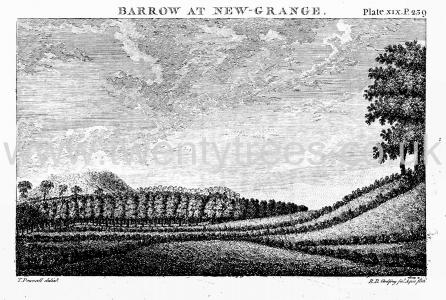
Pages 240-250 excluded. Discourse of history, not specific to Newgrange.
Before I proceed to give a more full and particular description hereof, it may not be improper to take notice of such accounts as have been already given of this monument. That by Mr. Edward Lhwyd1 is conceived in too general terms; and that given by Dr. Thomas Molineux, first published in the Philosophical Transactions, N°. 335 and 336, and afterwards in his discourse on Danish forts in Ireland, annexed to the Natural History of Ireland, and copied into the late editions of Ware’s History, was composed from a narrative and drawing given by Mr. Samuel Molineux, a young gentleman of the college of Dublin. The measurements are not exact; his observations upon particular parts are hasty, inattentive, and not just; and the drawings are mere deformities, made out at random. The account therefore which the Doctor gives is of that kind, which one might expect from such imperfect materials. Mr. Wright says he was on the spot, and in the cave, as it is called, and made some drawings of the cells in it; yet the account he gives in his Louthiana is but short, and little more than a transcript from Dr. Molineux; which is the more to be regretted, as he has an eye of precision, is an excellent draughtsman, and has been very accurate and distinct in all the other accounts which he has hitherto published.
Besides the more general observations and measurements which I made on the spot; and the sketches which I took of the whole, and of its parts, I engaged Dr. Norris to employ a person to make a particular measurement of the base and altitude of the pyramid; and to measure the gallery and cave, and every stone of which the gallery and cave is formed. This was done by Mr. Samuel Bouie, a land surveyor in that part of the country. I have every reason to confide in his actual measurements, though I have some reason to doubt of his projection of the altitude. The form indeed of the ground on which this pyramid stands makes that projection a matter of some difficulty. Dr. Molineux, who agrees nearly with Mr. Bouie in the actual measurements, which I find to correspond with my own notes, says, that the altitude is 150 feet, while Mr. Bouie makes it but 42. Neither of these accounts can be right, but Mr. Bouie, in my opinion, approaches nearest to the truth; for from a projection made upon a medium of the measurements given by Dr. Molineux, and those at different times received from Mr. Bouie, I make the altitude to be about 56 feet from the horizontal line of the floor of the cave; to which adding the segments of the curve of the ground on which it stands, being about 14 feet more, I make the altitude in the whole about 70 feet. This projection forms a figure exactly of the same contour as the draught which I sketched on the spot gives; and as my eye, from a habit acquired by drawing from nature, will judge of outlines and angles with an accuracy nearly approaching to measurement, I find myself from this concurrence the rather more confirmed in my opinion. How Dr. Molineux could be led into the mistake that the altitude was 150 feet, I cannot conceive. For if this monument, which is at present but a ruin of what it was, could be supposed ever to have been a perfect pyramid, it could not be much above 100 feet, as any one, continuing the lines of the sides to their interfections, will see. But even that supposition cannot take place, as Dr. Molineux mentions the circumference of the top nearly in the same numbers as Mr. Bouie makes it; and that the top so described by him was the perfect finishing of this monument is plain, as he mentions that one of the large columnal unhewn stones was set upon it.
In PI. XX. the figure B gives the plan of the base [of Newgrange Passage Tomb [Map]] drawn according to Mr. Bouie’s stations in measuring it; but you must understand, that the periphery of the real figure is curvilinear, not rectilinear. This base covers about two acres of ground. C is the plan of the cave and of the gallery leading to it; as it bears 240 N. W. D is the section of the pyramid, and of the ground on which it stands projected from a medium of the various numbers I have received. The whole is laid down by a scale of 84 feet to an inch.
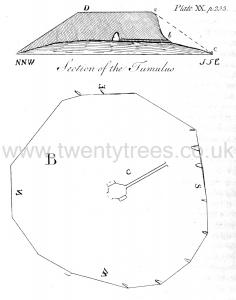
This pyramid was encircled at the base with a number of enormous unhewn hones, set upright, of which ten were remaining when I was on the spot. These you will see marked in the plan. Nine of them are still in their erect posture, the tenth is thrown down. I measured many of these stones, and found them from, seven to nine feet high above ground; that which is thrown down, and lies quite out of the ground, measured near eleven feet. Their forms are various and anomalous. Upon a rough estimate they may be supposed to weigh from eight to twelve tons each. Mr. Lhwyd fays, there was a stone of considerable bulk erected on the summit of this pyramid, of the same anomalous form as the others, but of less size. But there were no remains of such, when I was there. Many such hones as these are found on the sea-coast, as Dr. Norris, in answer to a particular inquiry made by me, informs me; and these must certainly have been brought from thence1.
Note 1. The reader will find, in a postscript to this, letter, some account of the removing of these immense masses of stone; and of the method which I supposed to be used by the ancients, as I collected that method from Herodotus.
The pyramid, in its present state, is, as I said, but a ruin of what it was. It has long served as a s quarry to the country round about. All the roads in the neighbourhood are paved with its stones; immense quantities have been taken away. Mr. Lhwyd mentions the particular instance which gave occasion to the discovery of the gallery that leads to the cemetery. The mouth of this gallery, under the perfect state of the monument, lay concealed and shut up near 40 feet within the body of the pile. The dotted line a b, in the section D, PI. XX gives the supposed perfect side. The triangle a, b, c, is the hollow space from whence, as from a stone quarry, the stones have been taken; b marks the mouth of the gallery. This gallery is formed by large flag stones. Those which compofs its sides are set on edge, and are of different altitudes, from two to seven feet high, and of various breadths from two to three feet six inches, as may be seen by the figures in the plan PL XXI; where the figures on the outside denote the altitude of the stones; those on the inside their breadth. The thickness of each could not be taken with any certainty; but some of the large ones which form the cemetery are from one foot and an half to two feet thick.
Fig. 1. and 2. in PI. XXI. give perspective sections of the gallery, and of the east and west tabernacles or niches in the cemetery. Fig. 1. in the succeeding plate is a perspective section of the north side opposite to the entrance.
One of the stones marked Q, fig. 3. PI. XXI. which lies across, and forms part of the top or roof of the gallery, is thirteen feet long, and five feet broad; another at L is eleven feet long, and four feet six inches broad.
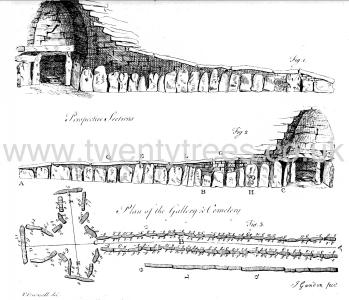
This gallery at the mouth is three feet wide, and two feet high. At thirteen feet from the mouth it is only two feet two inches wide at the bottom, and of an indeterminate width and height. Four of the side stones, beginning from the fifth on the right hand, or eastern fide, stand now leaning over to the opposite side; so that here the passage is scarce permeable. We made our way by creeping on our hands and knees till we came to this part. Here we were forced to turn upon our sides, and edge ourselves on with one elbow and one foot. After we had passed this strait, we were enabled to stand; and, by degrees, as we advanced farther, we could walk upright, as the height above us increased from fix to nine feet. At H in the section fig. 2. PI. XXI. I observed, that on one of the side stones, were the traces of a spiral line; but whether meant for any emblem, or, whether having any reference to this building, I leave to the curious to decide. Were I to indulge my own conjecture, I should rather suppose, that this stone, as well as some others in the compilation of this structure, had formerly belonged to some other monument of a much more ancient date, and that they were brought from the sea coast indiscriminately with the rest of the materials, and without knowledge of their contents, as well as without reference to the place they were here fixed in, being placed just as the shape of the stone suited the place assigned it. The distance from A to B in the ground plot PI. XXI. fig. 3. is 42 feet; from B to C is 19 feet 4 inches, from C to D 19 feet 2 inches; from E to F 21 feet. You will observe from the plan, that, although the cemetery is an irregular polygon, yet it is such an octagon as might be supposed to be formed with such rough materials into so rude a style of architecture. The dome of this cave or cemetery springs at various unequal heights, from eight to nine and ten feet, on different sides, forming at first a coving of eight sides. At the height of fifteen or sixteen feet the north and south sides of this coving run to a point like a gore, and the coving continues its spring with six sides; the east side coming to a point next, it is reduced to five sides, the west next ; and the dome ends and closes with four sides; not tied with a key stone, but capped with a flat flag stone of three feet ten inches by three feet five. The construction of this dome is not formed by key stones, whose sides are the radii of a circle, or of an ellipsis converging to a center. It is combined with great long flat stones, each of the upper stones projecting a little beyond the end of that immediately beneath it; the part projecting, and weight supported by it, bearing so small a proportion to the weight which presses down the part supported, the greater the general weight is which is laid upon such a cove, the firmer it is compacted in all its parts. This will appear without any further explanation from a bare inspection of fig. 1. and 2. in PI. XXI.

The eight sides of this polygon are thus formed. The aperture which forms the entrance, and the three niches, or tabernacles, make four sides, and the four imports the other four. Upon the whole, this cemetery is an octagon with a dome of about 20 feet in height, and of an area which may be circumscribed within a circle of seventeen feet, or seventeen and an half. Fig. 1 . PI. XXII. gives a view of the tabernacle opposite to the entrance, as fig. 1 and 2. pi. XXI. do of the two side ones. I will begin my description with that on the east, or right hand; each side of this consists of two stones standing erect, in the position, and of the dimensions, as marked in the plan fig. 3. PI. XXI.; the back is formed by a large flat stone laid edgeways at its length; its position and dimensions are also marked in the same plan. The whole is covered with one large flat ftone, sloping towards the back, and thus forms what, in the language of the old British inhabitants, is called a Kiftvaen. The northern tabernacle is constructed exactly as the eastern one. The other on the western, or left hand side differs, each side of it being composed but of one single stone, as may be seen in the plan. Where the back stone does not reach quite up to the top covering stone, there the space is compleated by a kind of masonry of three courses. The northern tabernacle hath for its floor a long flat stone, six feet eight inches long, by four feet eleven inches broad. The two side niches have no other floor but the natural ground. They have however each of them a rock bason placed within them. That in the left hand nich stands on the natural ground. That on the right is placed upon a kind of base. It appeared to me, when I made my sketch, rather convex than as it is described by others, and as given to me by Mr. Bouie. But herein I may have been missed by the earth which lay about it. As this bason seemed to have the sides of its concave fluted, I desired particularly that the surveyor might clean it, and wash it; that if there was any thing singular, it might be observed. Nothing particular was found there; so take the draught just as I first sketched it. The bason on the right hand, as the surveyor gives me the measure, is four feet nine inches, by three feet four; as I measured it, it is three feet eleven inches, by three feet five. The surveyor's measure of the base is six feet, by five feet four inches. The bason in the left hand tabernacle is exactly of the same form as the other; its dimensions four feet four inches, by three feet seven. In the narrow point of its oval it is two feet broad. Dr. Molineux, in his account of this cemetery, says, that there was a rock bason in each nich; and, as that stone which I have described as a base, is a concave, forming a bason like the rest, it may, at the first view, seem to give some foundation for this account. But Mr. Lhwyd says expressly, "that in each cell or apartment on the right and left hand was a broad shallow bason of stone; the bason on the right hand stood within another; that on the left hand was single; and in the apartment straight forward there "was none at all." As this account was prior to the Doctor’s, and as both the drawing and plan from which the Doctor wrote, describe this base stone (which one might suppose to be the third bason) as actually then standing as a base to the right hand bason, it is clear that the Doctor was mistaken; and indeed a bare view of the inaccurate plan from which he wrote his description shews how that mistake arose. He was informed of the basons in the side niches, and had a deformed draught of the right hand one. In pursuing his description from inspection of the plan, it is plain that he mistook the plan of the floor stone of the northern nich for that of a bason like those before described; and by looking on that plan, one sees how easily he might so do. I have employed a more particular precision in describing the peculiar differences in the three several niches or Kiftvaens, as they become to me a ground of a conjecture which I shall submit to you.
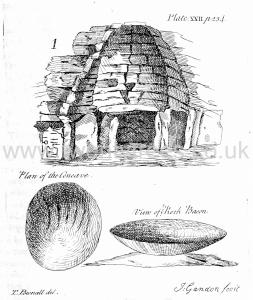
Examining very narrowly, with a candle in my hand, all the parts of this cemetery, I discovered on the flat stone which forms the north side of the left hand nich, what I took to be the traces of letters. Their form is given in the wooden cut annexed. These lines were of a breadth and depth in which I could lay the nail of my little finger; and of different lengths from two to fix inches! I tried for some time to assign, if, possible, these letters to some known alphabet, by comparing them particularly with that of the Beth-luis-nion, or old Irish alphabet; but this produced nothing satisfactory. As I had continued in this cave a much longer time than was prudent, by which I caught a violent illness; and as the tracing these lines with greater accuracy, would take up more time than I could then give to it, I gave over the talk, referring it to be done at leisure by the surveyor, whom Dr. Norris was so good as to engage. Mr. Bovie accordingly traced this supposed inscription; and, as it appears to me, faithfully, and with due care. The several copies which came from his hands at different times vary somewhat; but the variations are such, as rather mark than discredit the copyist’s attention. However, to fix this matter with as much accuracy as could be, I directed a facsimile to be taken by impression. That which is here represented is what Mr. Bovie sent as such. I hope it is exact, as I have done every thing in my power that it should be so.
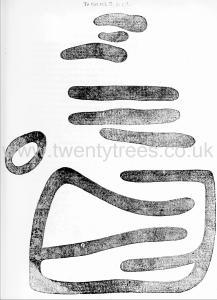
These characters are evidently neither Irish, Runic, nor Saxon: They have been compared with all the exemplars of every northern character; but no traces of any likeness have been found between them. There has not, amongst those whom I have consulted, or to whom these characters have been referred, been the least guess attempted as to any reading of them. I will therefore hazard a conjecture of my own; an use may arise even from conjecture.
[Continues with discussion of letters. See original.]
Before I close this description, I would just observe, that there are on some of the stones which form the sides and backs of the Kistvaens, lines cut in a spiral form. In the front edge of one of the stones which form the top of the Kistvaens there appear some lines forming a kind of trellis- work, in small lozenges, such as are not unfrequently seen on Danish monuments and crosses.
Having thus finished my description of this monument, permit me now to direct your view to some of those many instances, where monuments of a pretty similar nature occur in other countries; and that from Tartary, through both the northern and southern limits of Europe.
The first which present themselves in this view are the Bougres, in the Stepps of Tartary. We will begin with these from the most early accounts history affords us of them. In the Melpomene of Herodotus, c. 71. it is said, "That the sepulchres of the, Scythian kings are in the country of the Gerrhians, where the Borysthenes is first known to be navigable. When their king dies, they dig the ground a great hole, of a quadrangular form, and having ...
[Continues with descriptions of other known monuments.]